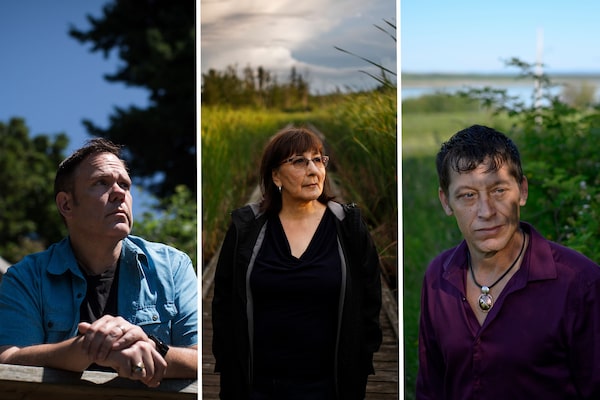
Nicholas Harrison, Evelyn Korkmaz and Rob Bowden are still haunted by memories of the sexual abuse they allegedly received from Catholic clergy when they were children.Darryl Dyck, Blair Gable and Darren Calabrese/The Globe and Mail
Rob Bowden, a goldsmith in Sydney, Cape Breton, is plagued by nightmares from the sexual abuse he suffered as a child. Evelyn Korkmaz in Ottawa has recurring flashbacks of the mental, physical and sexual abuse she experienced in the early 1970s at the notorious St. Anne’s residential school in northern Ontario, and sometimes stutters when she tries to speak. Across the country in Tsawwassen, B.C., Nicholas Harrison still bears a scar that snakes across his chin from when he says he was thrown down the stairs at school as an eight-year-old.
All three are survivors of clergy abuse. Yet, even after decades of abuse-related scandals in the Catholic Church, there is little understanding of how many other walking wounded there are across Canada, and the true scope of the damage.
In countries such as Australia, the United States and Ireland, revelations of the scale of abuse meted out by Catholic priests and other religious figures have been making headlines and forcing meaningful changes, spurred by a combination of pressure from survivors’ groups, public outrage and criminal investigations.
But such a broad reckoning has yet to unfold here in Canada, where we are still trying to grasp the enormity of the abuse against thousands of First Nations, Inuit and Métis boys and girls at residential schools, many of which were Catholic run.
The Truth and Reconciliation Commission’s 2015 findings yielded the clearest view so far of the depth of damage inflicted against children. The reconciliation process has much further to go. At the same time, the Church has yet to acknowledge the full scale of abuse in parishes, schools and other institutions across the country.
Instead, survivors have been left to try to force change on their own.
This week, victims from all corners of Canada will gather in Cornwall, Ont., site of the annual meeting of the Canadian Conference of Catholic Bishops (CCCB). They’re hoping to force abuse-related reforms onto the agenda and demand a response from the 90 bishops who’ll be attending the five-day summit.
Survivors are pushing for more transparency and accountability from leaders of the Catholic Church – an institution that has chosen a path of secrecy and defensiveness, even as it has paid out millions of dollars in quiet settlements to victims.
They are also calling for external oversight of how abuse claims are handled and outside investigations when allegations surface.
Many of their demands are similar to those made more than a decade ago. They’re tired of waiting, and as their slogan goes, they want action now.
Gemma Hickey is one of the clergy-abuse survivors who spoke with The Globe and Mail.Darren Calabrese/The Globe and Mail
As a first step, the survivors are asking that the names of credibly accused priests be posted publicly – something that’s already happening in the United States. “That would be a big step forward on the path to reconciliation,” says Gemma Hickey, a survivor in St. John’s who, in 2013, founded the Pathways Foundation, a non-profit that supports survivors who have been harmed within religious institutions. “If we’re going to right these institutional wrongs, then we need to have complete transparency. And if they’re protecting people who are known offenders, then I believe those names should be released.”
Mx. Hickey (who uses gender-neutral pronouns) is one of nine clergy abuse survivors The Globe and Mail spoke to, many of whom report symptoms such as depression, anxiety, insomnia, substance abuse, anger issues and post-traumatic stress disorder.
The Globe also interviewed former priests, lawyers, scholars, database keepers, bishops, parishioners and experts in canon law in Canada, the United States, Ireland and Australia in an attempt to understand how the response to clergy abuse in this country compares to what’s happening elsewhere.
Almost eight in 10 Canadians – including half of practising Catholics – believe the Church has been doing a poor job of addressing sex-abuse issues, according to a recent survey by Angus Reid. And one in three practising Catholics say their own local church community has had problems with clerical sexual abuse over the past few decades; of those, nearly half said the issue was not adequately addressed.
But the fire has yet to be lit, says Halifax-based lawyer John McKiggan, who has represented victims in clergy sexual-abuse cases for 30 years.
“There hasn’t been the moral outrage or the political will, perhaps, to do this type of investigation.”
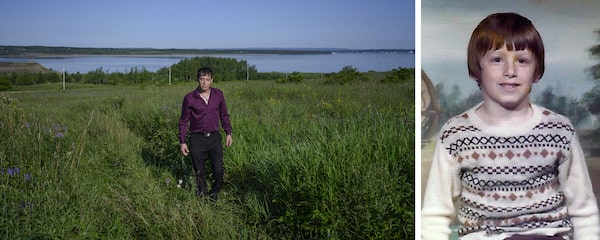
Rob Bowden shown as an adult in Cape Breton, where he lives, and as a child, when he says he was abused by clergy. He doesn’t think the Catholic Church can reform itself from within, but instead requires change from outside.Darren Calabrese/The Globe and Mail; courtesy of Rob Bowden/The Globe and Mail
Evelyn Korkmaz, a Cree grandmother, says she was abused at St. Anne's Residential School in Northern Ontario. She wants an apology from the Church.Blair Gable/The Globe and Mail
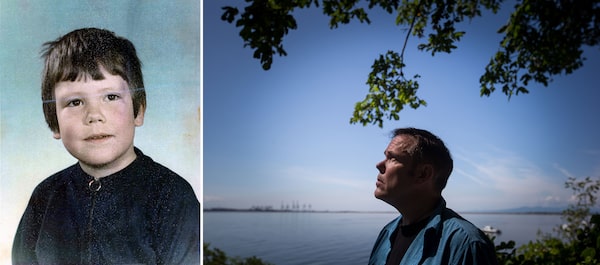
Nicholas Harrison has a scar on his chin, which he says he received when he was thrown down the stairs at school. He was 8 at the time.Courtesy of Nicholas Harrison; Darryl Dyck/The Globe and Mail/The Globe and Mail
One of the earliest publicized sex-abuse scandals happened right here in Canada, at the Mount Cashel Orphanage in Newfoundland, run by the Christian Brothers, a Roman Catholic order. Allegations began trickling out in the 1970s, and two inquiries into the horror started in 1989.
Yet, three decades later, Canada still has no nationwide numbers on the magnitude of the damage inflicted on children by priests and religious brothers of the Catholic Church. And other than the TRC, there has been no sweeping national inquiry – just regional ones.
Canada is “certainly well behind Australia and the United States” in confronting the issue of clerical sexual abuse, says Des Cahill, a former Catholic priest and professor emeritus at RMIT University in Melbourne, Australia. Few people have a better global overview of the issue than Prof. Cahill: A few years ago, he co-authored a 384-page paper examining responses from both governments and the Catholic Church to the abuse crisis in countries including Canada, Belgium, the United States and Australia.
Those latter two countries offer concrete examples of how Canada might tackle the issue.
The spark for many changes in the United States came 17 years ago, thanks to a groundbreaking Boston Globe investigation of abuse and cover-ups by Catholic clergy in Boston. (The film based on the coverage, Spotlight, won best picture in 2016.) The investigation drew global attention and sparked waves of further revelations.
It also brought about real reform. The same year the story broke, the bishops established a lay advisory board, the National Review Board, to advise the U.S. Church on child protection. Soon into its mandate, the board commissioned a study by John Jay College of Criminal Justice, at the City University of New York. It found that 4,392 were accused of sexual abuse of minors between 1950 and 2002, with very few ever convicted. (The number has since surpassed 6,000, according to the website Bishop Accountability.)
The initial report found the prevalence of abusive priests was four per cent; more recent estimates from Bishop Accountability, which maintains an abuser-priest database, put it at least at six per cent.
In August, 2018, a groundbreaking Pennsylvania grand jury report showed credible allegations against more than 300 “predator priests” in the state who had sexually abused more than 1,000 children since the 1940s. The revelations opened the floodgates, and since that release, attorneys-general in more than 15 states have started their own investigations. Diocese after diocese across the country has had to release the names of credibly accused priests and clergy members – more than 1,500 in the past year alone.
Most recently, Catholic bishops in the United States voted this past June to create a new national sex-abuse hotline by next year, run by an independent third party, which will take complaints against bishops over abuse or cover-ups. U.S. church leaders are being held accountable: Bishop Robert Finn resigned in 2015 after failing to report abuse, and ex-cardinal Theodore McCarrick recently became the most senior cleric in modern history defrocked due to sexual abuse.
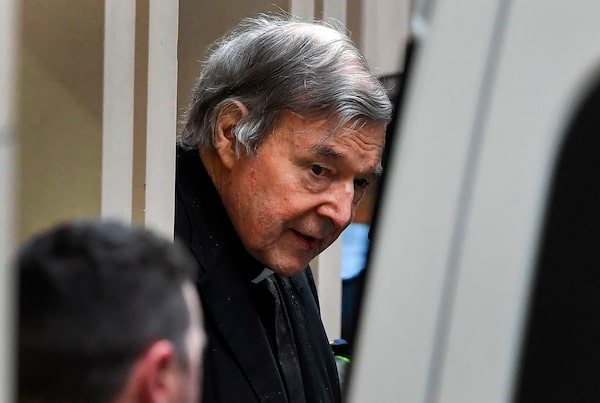
Melbourne, 2019: Australian Cardinal George Pell is escorted in handcuffs from the Supreme Court of Victoria.William West/AFP/Getty Images
Meanwhile in Australia, Cardinal George Pell, a former advisor to Pope Francis, became the highest-ranking Roman Catholic leader ever convicted of child sexual abuse, after he was found guilty in December, 2018, of abusing two choir boys. (He is appealing the verdict.)
Sweeping reforms are now under way after the country’s Royal Commission into Institutional Responses to Child Sexual Abuse produced the most comprehensive report of its kind in the world. The final report, issued in 2017, identified 4,444 victims of child sexual abuse, based on Catholic Church data, between 1980 and 2015, with more allegations of such abuse related to the Catholic Church than any other religious organization.
The Royal Commission calculated that seven per cent of priests in Australia allegedly abused minors within their flock over a 60-year period. In one Catholic order, the St. John of God Brothers, which oversaw facilities for children with disabilities, the share of religious brothers who were alleged perpetrators was a staggering 40.4 per cent.
As a result of the recommendations, in 2018, Australia’s government created a National Office for Child Safety that works to prevent child abuse and monitor efforts at organizations including the Catholic Church.
Reforms have also rippled through Ireland, where the Church must report all abuse allegations (including those made by adults about abuse that took place in their childhood) to police and social services. The National Board for Safeguarding Children in the Catholic Church is a watchdog that provides oversight in how the Church handles child-protection issues. The board has audited each diocese and published reports on each, which include reviews of all allegations over the decades. It found allegations of abuse in every diocese it investigated.
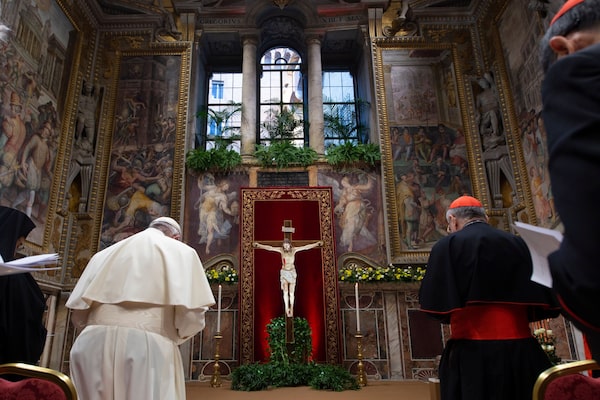
At the Vatican's Apostolic Palace, Pope Francis, left, prays during a Eucharistic celebration on the fourth and final day of a historic global summit on child sex abuse.Vatican Media/AFP/Getty Images
Earlier this year, the Vatican held its first ever summit on preventing clergy abuse. In May, Pope Francis issued new rules that require Church officials to report cases of abuse and attempts to cover them up to their superiors.
But many survivors say the measures fall short, since the Church can’t be trusted to police itself.
Here in Canada last year, the CCCB released updated guidelines on protecting minors from sexual abuse, which garnered praise from the Vatican. But there’s no firm timeline for their implementation, and each of the 69 recommendations state that bishops and major superiors will “endeavour” to follow them, not that they must.
The Globe sent an extensive list of questions to the CCCB in July, asking for, among other things, the number of credibly accused priests in Canada since 1950 and the number of children who have been assaulted by priests. The CCCB provided no numbers, noting that the Canadian conference has evolved differently from its U.S. counterpart on this issue, with the American conference playing a more centralizing role, and that the CCCB does not conduct statistical research. Instead, the country’s 76 dioceses operate as autonomous entities, each governed by a bishop.
In protecting minors, “the response of the bishops has always been to provide the kind of national response which could then be adapted and implemented at the local/diocesan level,” the CCCB stated in the letter. “The offices of CCCB are not mandated to supervise, oversee or manage how such resources [such as the guidelines on protecting minors] are used or implemented within each diocese.”
Indeed, according to Prof. Cahill, “Canada seems to be leaving it all to the individual dioceses” rather than developing national, overarching responses. On the Canadian Conference of Catholic Bishops’ website, it’s “very difficult to find anything on professional standards, child protection policy and so on. It’s certainly not up there on the front page,” he says.
The Globe made requests to speak with Archbishop Michael Miller in Vancouver, Bishop Lionel Gendron of the CCCB and several other bishops; these requests were either declined or ignored. The CCCB eventually promised an interview with Bishop Gendron, although not until after the bishop’s meeting.
In an interview last week, Bishop Robert Bourgon of the Diocese of Hearst-Moosonee, in northern Ontario, said “major steps” have been taken since Mount Cashel, although compared with other countries, “we’re behind the game as far as universal policies across the country."
In the absence of comprehensive numbers, cases in Canada tend to be reported in an isolated, local fashion. Since 2010, Sylvia’s Site, run by Sylvia MacEachern of Ottawa, has been collecting accusations of sexual abuse against Catholic priests or brothers based largely on media reports and court records. The site’s database includes roughly 350 names of accused clergy – and that’s just what’s on the public record. (Some of those clergy members were acquitted or the charges against them dropped.)
To make an educated guess at the scope of abuse, The Globe started by estimating the number of priests who have worked in Canada since 1950 (the Church refused to divulge even that number). Scraping a website listing of the number of priests who’ve worked in Canadian dioceses over the decades yielded at least 14,000 over the past 70 years.
Applying the U.S.’s 6-per-cent figure for the share of accused priests shows Canada could have more than 800 abuser-priests. Using Australia’s 7-per-cent rate yields at least 980 perpetrator priests, suggesting there could be thousands of victims.
“People who have come forward are the very tip of a very large iceberg,” says Mr. McKiggan in Halifax. “It isn’t just a few bad apples or just an isolated problem. The sheer number of accused or convicted priests suggests there is a systemic problem.”
In virtually every diocese in Canada, “people have come forward and out-of-court settlements were reached,” says David Deane, associate professor of theology at the Atlantic School of Theology in Halifax. There have been hundreds of settlements in total, says Dr. Deane.
According to media reports, the diocese of London, Ont., has paid out $15-million in settlements, most of them secret, while Moncton has paid more than $10-million in settlements. Mr. McKiggan secured a $15-million settlement from the Diocese of Antigonish for victims in 2009. Last year, a jury awarded nearly $2.6-million (including the largest-ever award of punitive damages for clergy abuse) to a single victim in Ontario. The Church is appealing. (In the U.S., the Church paid out nearly US$200-million in settlements to victims in 2017-18 alone.)
More allegations are surfacing all the time. Rob Talach – a lawyer based in London, Ont., who has been dubbed “the priest hunter” for his record of going after abusers – has 108 active Catholic cases involving clergy abuse in Ontario, Alberta, Manitoba, New Brunswick, Yukon and British Columbia. In Montreal, lawyer Virginie Dufresne-Lemire says her firm alone has five class actions under way related to clergy sexual abuse in schools, residential schools and parishes in Quebec, amounting to more than 500 victims.
“We have victims calling almost every day,” she says.
Publicizing the names of credibly accused priests would be 'a big step forward on the path to reconciliation,' survivor Gemma Hickey says.Darren Calabrese/The Globe and Mail
In the fall of 2015, Gemma Hickey attended a funeral in St. John’s. While walking down the aisle of the church, Mx. Hickey glanced at the wall and froze. There, in plain sight, was a framed picture of the priest who had abused them when they were younger.
“I felt like I had just been slapped in the face,” Mx. Hickey says. “I was shocked that his picture was still up there.”
When Mx. Hickey sat down at a pew and opened the Catholic Book of Worship, they received another shock. At the front of the missal was an introduction written by Raymond Lahey, a former bishop who had pleaded guilty years earlier to possessing child pornography; his laptop had contained hundreds of photos of young men and boys as young as nine wearing rosary beads and crucifixes.
When Mx. Hickey and other parishioners raised the matter with the local bishop, they say he told them, “‘Well, you can just cover it up – put something over it.’ And I thought to myself, ‘cover it up? Do you not see the irony in that?’ ”
Bishops in Canada have rarely, if ever, been held accountable for complicity or a cover-up, lawyers say. There’s “a very lackluster level of interest or attention in our criminal justice system for the big guys – the bishops and the archbishops and the people who move [abusive priests] around,” Mr. Talach says.
Leona Huggins of Coquitlam, B.C., knows all too well about what has been dubbed the “silent shuffle” – abusive priests who resurface in different parishes. The priest who abused her starting when she was 13, Father John McCann, was convicted of sex charges in 1992 after a guilty plea.
To her dismay, she found that he was working in a parish in Ottawa in 2011. It wasn’t until after a public outcry that he was removed; he was never defrocked.
Other priests have also reappeared. The Vancouver diocese received credible allegations against Father Damian Cooper in 1994, yet in 2005, he was reportedly listed as a spiritual director at the Fraser Valley Pregnancy Centre. The list goes on.
Ms. Huggins wants more transparency about who the perpetrator priests are and who allowed them to keep working.
“Without knowing how big it is, kids today can remain in danger,” she says. “So, we have to be able to see the scope of the cover-up – who allowed these men to stay in ministry? Who allowed John McCann to go back into ministering in Ottawa, around schools, for years? Who thought that was okay?”
Ms. Huggins is the Vancouver representative for the Survivors Network of those Abused by Priests and was one of 12 survivors who met with Vatican officials back in February. She’s hoping more transparency and disclosure will help bring comfort and validation to victims and their families.
“We as survivors know lots of people who committed suicide because they felt they were the only person who was abused by this (clergy member),” she says. “To me, there’s an ethical responsibility by the Church, which calls itself a moral authority, to disclose all the information they know.”
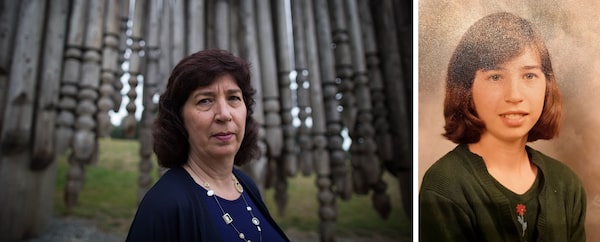
Leona Huggins of Coquitlam, B.C., shown as an adult and at age 13, when she was abused by a priest later convicted of sex charges.Darryl Dyck/The Globe and Mail; courtesy of Leona Huggins/Darryl Dyck/The Globe and Mail; courtesy of Leona Huggins
That could be a while coming.
Reverend John Comiskey, a bishop’s delegate whose job is to reach settlements with victims, agreed to speak with The Globe on behalf of the diocese in London, Ont. In an hour-long interview, Father Comiskey said the diocese doesn’t release details on the nature of abuse allegations. Nor does it plan to disclose the scope or aggregate numbers on settlements it has reached with victims of clergy abuse.
“We’ve never given that information, don’t intend to. We have been consistent with that. It’s not in the public interest to know that,” he said. “We’re not hiding numbers; we’re just not publicizing them.”
“We are accountable to whom we have to be accountable, but we don’t have to publicize all the information,” he added.
Dr. Deane from the Atlantic School of Theology believes the Church must acknowledge the full story of what happened in the past. “We need to have a truth-telling about this period in the Church’s history if we’re to move forward,” he says. “I wish that the church would somehow find the courage to become transparent and expose itself to outside investigation so that the full scale of these horrors can be told. Only then can we begin to conduct the reforms necessary.”
After 17 years spent representing victims of clerical abuse, Mr. Talach also has plenty of ideas on what needs to change.
One of the top priorities is improving Canada’s reporting regime. As it now stands, he says if someone walks into a diocese and says they were abused by a priest 40 years ago (because it typically takes decades for victims to come forward), and that priest is still functioning part-time in a parish – say, running its youth program – “the diocese has no obligation under law to report that to anybody.”
Instead, Mr. Talach believes these matters must be investigated by outside authorities.
Dr. Deane agrees. Currently, “you still have investigations into claims of sexual abuse being handled by all insiders,” he says. “It’s like Big Tobacco investigating itself – there’s zero chance of a proper outcome.”
Prevention is similarly crucial, Dr. Deane says. For starters, he says, all-male models of leadership “have to go."
So should celibacy requirements for priests, according to Mr. Talach. “We can do all the accountability, we can charge bishops, we can put all kinds of people in jail,” he says, “but unless we’re doing something to prevent more kids going down this road, there’s going to be folks like me employed 50 years from now.”
Morality aside, he says, “the lifelong cost on society and governments and families and the victims is huge. And we’re really doing nothing about it.”
Evelyn Korkmaz would like to start with an apology for the horrific abuse she and others lived through at residential schools. She's still seeking justice.
In February, the Cree grandmother travelled to Rome hoping to meet Pope Francis and ask that he apologize for the Church’s role in running the schools, 60 per cent of which were under Catholic control.
But the meeting was refused, and Ms. Korkmaz left hugely disappointed.
“It doesn’t help that the Vatican covers up these clergy abuses or crimes, by withholding names and the documents and relocating the clergy to other parts of Canada” or the world, she says.
Rob Bowden of Cape Breton was abused by a parish priest for three years, starting when he was eight, and was one of the plaintiffs in the successful class action lawsuit against the diocese of Antigonish. He doesn’t believe the Church can fix itself; rather, he believes any substantive change will have to come from the outside.
He’s done with excuses. “They destroyed my life, over and over. I’d love to see them held accountable.”
With files from Rick Cash and Stephanie Chambers, and data analysis from Jeremy Gray
Our Morning Update and Evening Update newsletters are written by Globe editors, giving you a concise summary of the day’s most important headlines. Sign up today.
 Tavia Grant
Tavia Grant